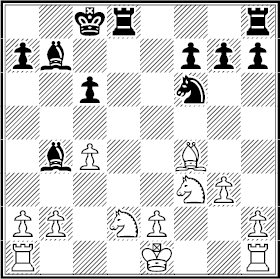
A double-edged move makes winning – and losing – more possible.
Nigel Short White
William Hartston Black
London 1976
English Opening A32
1 d4 ♘f6 2 c4 c5 3 ♘f3 cxd4 4 ♘xd4 e6 5 g3 d5 6 ♗g2!
Not 6 cxd5 ♕xd5! when Black attacks the h1-rook and is already better (7 f3 e5! or 7 ♘f3 ♕xd1+).
6...e5 7 ♘c2 d4 8 f4!?
Double-edged: Black would have been at least equal after 8 0-0 ♘c6 9 ♘d2 ♗f5. Now both sides have more at risk.
8...exf4 9 ♗xf4 ♘c6 10 ♗xc6+
White raises the stakes again. But he needed more play than 10 0-0 ♗c5.
10...bxc6 11 ♕xd4 ♕xd4 12 ♘xd4 ♗b7 13 ♘d2 0-0-0
Black has serious comp after 14 ♘2f3? ♗b4+ (15 ♔f1 ♘e4). Not 15 ♔f2?? g5! 16 ♗xg5 ♘e4+ and ...♘xg5.
14 ♘4f3 ♗b4

Black has yet to prove he has a pawn’s worth of play. For example, 15 a3! ♗xd2+ 16 ♘xd2 ♖he8 17 ♗g5. Or 16...♖d7 17 0-0-0 ♖e8 18 ♖he1.
15 0-0-0 ♖he8 16 ♘e5?
Again 16 a3! would have been good, e.g. 16...♗a5 17 ♘b3 or 16...♗f8 17 ♘e5!.
16...♗xd2+! 17 ♖xd2 ♖xd2 18 ♔xd2 g5
White may have counted on 19 ♗xg5 ♖xe5 20 ♗xf6 but overlooked 19...♘e4+.
19 ♘xf7 ♘e4+! White resigns.
White is denied 19...gxf4 20 ♘d6+.
Alexander Raetsky White
Dieter Knoedler Black
Zurich 2002
1 d4 e6 2 c4 ♘f6 3 g3 c5 4 ♘f3 cxd4 5 ♘xd4 d5 6 ♗g2 e5 7 ♘c2 d4 8 f4 ♘c6 9 ♗xc6+ bxc6 10 fxe5 ♕a5+ 11 ♕d2 ♕xe5 12 ♕xd4 ♕h5!? 13 ♕e3+ ♗e6 14 b3 ♖d8 15 ♗b2 ♗c5 16 ♕f3?? ♕xf3 17 exf3 ♗f5 White resigns.
Question 223: Why resign?
Question 224: And why not 14 ♘d4 ♗c5 15 ♘xe6 so that 15...♗xe3 16 ♘xg7+ ?